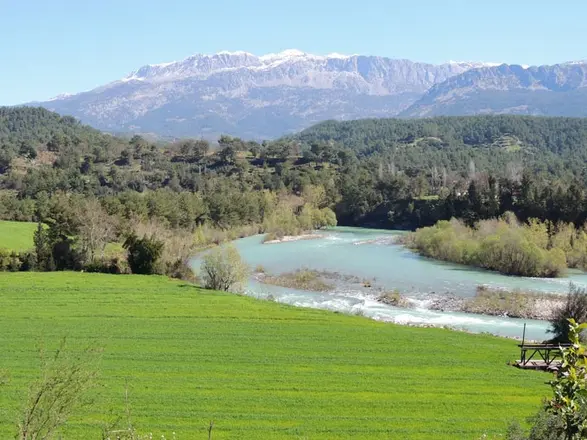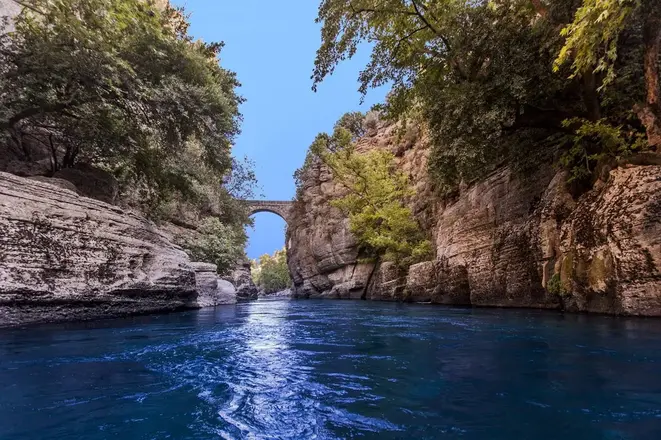Köprülü Canyon National Park
Description
Geological Structure
The geological structure of the region consisting of clay, sandstone, conglomerate and limestone rocks allows the formation of karst landforms. The rift valley formed by the Köprü River, which is the main source of the national park, between Bolasan Village and Beşkonak is the longest canyon in our country with a length of 14 km and walls exceeding 100 meters.
The most selective feature that makes Köprülü Canyon National Park important is the morphologically formed canyon structures. Within the National Park, there are rock formations that the local people call man rocks or devil rocks. In addition to these formations, the National Park has a two-part main canyon with a depth of 500 m and a total length of 12 km, and a second 2 km long canyon connecting the valley with cypress forests to Köprüçay.
There are 13 geological formations with different lithologies in Köprülü Canyon valley and Antalya-Köprülü Canyon National Park, which is located in the Karstic belt of the Central Taurus Mountains.
FAUNA
Mammals It was determined that 37 mammal species belonging to 16 families are distributed in the National Park. This constitutes 1/5 of all mammal species (approximately 170 species) in Turkey. The main mammal species are wild goat, caracal, lynx, deer, mountain goat, bear, fox, wolf, rabbit, marten and badger.
Birds Within the boundaries of Köprülü Canyon National Park, 148 bird species belonging to 14 orders and 41 families that make up the avifauna were identified. Red vulture, rock nuthatch, woodpecker, caracal woodpecker, axillary woodpecker, rock sparrow, swift, swift eagle, rock eagle, stone-redstart, redstart, red bunting, snake eagle, rock pigeon, rock swallow, rock bunting are the most important bird species.
Fish There are 7 fish species (2 of which are exotic) in the National Park. The fish species identified in Köprü Stream, which gives its name to the National Park, are Trout, Barbus, Siraz, Flower fish, Pool fish, Rainbow trout.
Reptiles: There are 25 different reptile species belonging to 13 families in the National Park. Some of them are Tortoise, Striped Turtle, Blind Lizard, Corrugated Lizard, Blind Snake, Black Snake and Hazer Snake.
FLORA
The following features have been identified as conservation priorities: The pure cypress (Cupressus sempervirens) forest is the most important natural resource value of the National Park. The approximately 400 hectares of natural cypress forest in Köprülü Canyon National Park is the largest natural cypress forest in the entire Mediterranean region, where it was once widely distributed. Old-growth coniferous forests - old-growth larch (Pinus nigra) forests mixed with cedar (Cedrus libani) and Taurus fir (Abies cilicica ssp. isaurica) are of great ecological importance. With its rich and varied flora and around 950 taxa, 230 of which are endemic, Köprülü Canyon National Park is of great ecological importance.
CULTURAL AND ARCHAEOLOGICAL VALUES
The national park has rich cultural resources as well as natural beauties. The theater, agora, temples of Zeus and Artemis, cisterns, aqueducts, aqueduct, Oluk and Büğrüm bridges over the Köprü River and Kocaçay, and the stone-paved historical road connecting Selge to the coastal cities of Pamphylia are the most striking examples of the ruins of the ancient city of Selge, founded in the 5th century BC.
The people living in the area have their own unique culture. Although these people are in contact with the modern world, they also maintain their traditions. A transhumance lifestyle has developed along with animal husbandry. The architecture using stone materials unique to the region is also an important cultural value. There is Büğlüm Köprü Day Use Area within the National Park. There are toilets, fountains and a viewing terrace in the Day Use Area.
BRIDGE CANYON NATIONAL PARK ATTRACTIONS
Pure Cypress Forests,
Old Coniferous Forests,
Koprucay River
Adam Rocks (Devil Rocks)
Canyons
Bozburun Mountain
Selge Ancient City and Waterway,
Gutter Bridge-Curve Bridge
King's Road
Aqueduct
Watchtower
11 villages in and around the National Park
Hiking Routes
Daily Use Area.
ACTIVITIES THAT CAN BE DONE IN KÖPRÜLÜ CANYON NATIONAL PARK
Observation of Rich Vegetation and Geological Structure,
Wildlife Observation,
Nature Walk
Picnic
Photography Opportunity,
Rafting,
Canoe Sport
Orienteering,
Tent / Caravan CampingAnglingCanyoningPlateau Tourism,Horseback WalkingCycling Sports are available.The National Park is reached by an asphalt road departing from the 49th km of Antalya - Manavgat highway. This road leaves the Mediterranean coast and passes through Taşağıl and reaches Beşkonak.
Short Description
The geological structure of the region consisting of clay, sandstone, conglomerate and limestone rocks allows the formation of karst landforms. The rift valley formed by the Köprü River, which is the main source of the national park, between Bolasan Village and Beşkonak is the longest canyon in our country with a length of 14 km and walls exceeding 100 meters.






